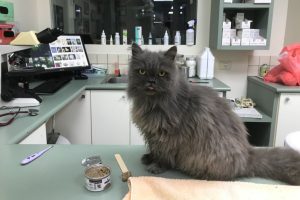Is your feline friend stumbling more often than usual? Cats are typically graceful creatures, so it can be concerning when they start to display clumsy behavior. If you’re wondering why your cat is acting clumsy, you’re in the right place. Let’s explore the potential reasons behind this unexpected behavior.
Sometimes, clumsiness in cats can be attributed to a medical issue. It’s essential to rule out any underlying health problems that could be causing your cat’s uncharacteristic lack of coordination.
Lack of Focus or Distraction
Is your cat often seen trying to chase a fly around the room or getting easily distracted by a sudden movement? Well, just like us when we get lost in thought and trip over our own feet, our feline friends can also become clumsy due to lack of focus or distractions.
When cats are not fully alert or focused on their surroundings, their coordination and balance can take a hit, leading to those comical stumbles and tumbles. To help your cat stay sharp and avoid clumsy mishaps, try creating a calm and quiet environment for them to play and move around in. Interactive toys or engaging in playtime together can also help keep your cat mentally stimulated and less likely to be distracted.
Remember, just like us, our cats can also have ‘off’ days where they may be more easily distracted or less focused. So, be patient and understanding with your furry companion as they navigate through their daily adventures.
Ear or Eye Problems
Have you noticed your cat bumping into objects or misjudging distances more frequently? It could be a sign of ear or eye problems affecting their balance and coordination. Issues such as ear infections or vision impairments can impact how well your cat can navigate their environment, leading to clumsy behavior.
If you suspect that your cat may be experiencing ear or eye problems, it’s essential to consult your veterinarian for a thorough examination. They can help diagnose any underlying issues and recommend the appropriate treatment to help your cat regain their balance and coordination.
Additionally, be mindful of any changes in behavior or physical symptoms that may indicate an issue with your cat’s ears or eyes. Early detection and treatment can help prevent further clumsiness and ensure your feline friend stays happy and healthy.
Remember, our cats rely heavily on their senses to move gracefully and confidently, so keeping their ears and eyes in good health is essential for their overall well-being.
Arthritis or Joint Pain
If you notice your cat stumbling around more than usual, arthritis or joint pain could be the culprit. Just like how achy joints can make us humans feel a bit clumsy, the same goes for our feline friends. Arthritis can strike cats of any age, but it’s more common in older kitties. So, if your cat is getting up there in years, a trip to the vet might be in order to get a proper diagnosis and treatment plan in place.
And hey, just like how a warm cup of tea can soothe our achy joints, there are things you can do at home to help your cat feel more comfortable. Providing cozy bedding, gentle exercise, and even special joint supplements recommended by your vet can all contribute to easing your kitty’s discomfort. Remember, a little TLC can go a long way in helping your cat move around with more grace and less clumsiness.
Environmental Factors
Have you recently rearranged your furniture or introduced new objects into your cat’s space? Well, just like how we can feel a bit off-balance in a new environment, the same goes for our furry friends. Changes in their environment can throw off their usual sense of coordination and balance, leading to some clumsy behavior.
So, if you’ve noticed your cat tripping over things more frequently or struggling to navigate their surroundings, take a look around and see if anything has changed. Maybe that new plant in the corner is just a bit too tempting to resist, or perhaps the rearranged living room layout is throwing off their usual routine. By identifying and addressing these environmental factors, you can help your cat regain their footing and move around with more confidence.
And don’t forget, a little extra playtime and attention can also help alleviate any stress or uncertainty your cat may be feeling in their changed environment. Remember, a calm and happy cat is a cat less likely to be tripping over themselves! ?
Age-Related Changes
As cats get older, it’s normal for them to experience some changes in their physical abilities, which can manifest as clumsiness. Just like humans, cats can suffer from conditions like arthritis that affect their coordination. Additionally, their vision and hearing may not be as sharp as before, making them more prone to tripping or bumping into things.
If you notice your older cat being more clumsy than usual, it may be a good idea to schedule a check-up with your veterinarian. They can assess your cat’s overall health and provide guidance on how to make your home more senior-cat-friendly, such as using ramps or steps to help them navigate elevated surfaces more easily.
Remember, aging is a natural process, and providing your cat with the extra care and attention they need during this time can help them stay comfortable and happy in their golden years.
Neurological Conditions
Cats can also experience clumsiness due to underlying neurological conditions that affect their coordination and balance. Conditions like vestibular disease or brain tumors can cause symptoms such as head tilting, loss of balance, and overall unsteadiness.
If your cat is displaying signs of clumsiness along with other concerning symptoms like seizures or changes in behavior, it’s crucial to seek veterinary attention promptly. A thorough neurological examination and diagnostic tests will help determine the underlying cause of your cat’s symptoms and establish a treatment plan.
In the meantime, ensure your cat’s environment is safe and free of hazards that could potentially worsen their clumsiness. Keeping sharp objects out of reach and providing stable surfaces for your cat to walk on can help prevent accidents until you can consult with a professional.
Additional Insight: Regular play and exercise can help improve your cat’s coordination and balance, even if they are experiencing age-related changes or neurological conditions. Interactive toys that encourage movement and engagement can be beneficial in maintaining your cat’s physical abilities and overall well-being.
Nutritional Deficiencies
Is your feline friend stumbling more than usual? Well, it might be due to their diet lacking essential nutrients. Just like us, cats need a balanced diet to stay healthy, active, and coordinated. Make sure your cat’s food provides all the necessary vitamins and minerals they need to thrive. Vitamin B12 deficiency, for example, can lead to neurological issues, affecting their coordination and balance. Ensure their food contains enough protein, fats, vitamins, and minerals to keep them in top shape.
Interactive Toys and Enrichment Activities
Looking for a fun way to help your clumsy cat improve their coordination? Engaging them in interactive play and providing enrichment activities can work wonders. Toys that encourage physical activity and mental stimulation can help enhance their motor skills and agility. Consider investing in toys like feather wands, interactive treat puzzles, or cat trees to keep your furry friend entertained and active. Remember, a happy and engaged cat is likely to be more agile and graceful. So, let the games begin!
For more information on cat health and behavior, check out this valuable resource on cat enrichment!
Alex, a passionate animal lover, has experience in training and understanding animal behavior. As a proud pet parent to two dogs and three cats, he founded AnimalReport.net to share insights from animal experts and expand his knowledge of the animal kingdom.




